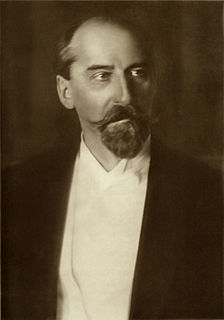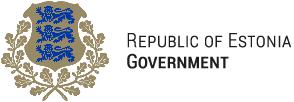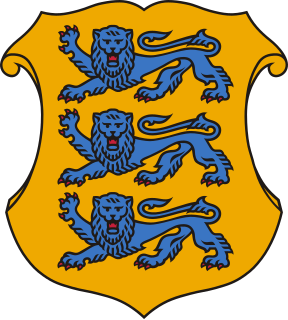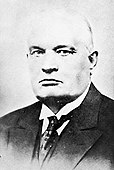Otto August Strandman was an Estonian politician, who served as Prime Minister (1919) and State Elder of Estonia (1929–1931). He was one of the leaders of the centre-left Estonian Labour Party, that saw its biggest support after the 1919 and 1920 elections. Strandman was a key figure in composing the radical land reform law and the 1920 Constitution. He also served as Minister of Agriculture (1918–1919), Minister of Justice, Minister of Finance (1924), Minister of Foreign Affairs and Minister of War (1919). While he was in the office of Minister of Finance, he stabilized the economy and managed to avoid hyperinflation. Strandman was also the speaker of both the Estonian Provincial Assembly (1917–1918) and Riigikogu (1921). He was a diplomat, serving as an envoy in Warsaw (1927–1929), when he made contacts with Polish politicians, and in Paris (1933–1939). During the Soviet Occupation in 1941, Strandman was ordered to show up to the NKVD headquarters. Already knowing about his fate, he committed suicide in his home in Kadrina.
The Social Democratic Party is a social-democratic political party in Estonia, currently led by Jevgeni Ossinovski.

Konstantin Päts was the most influential politician of interwar Estonia, and served five times as the country's head of government. He was one of the first Estonians to become active in politics and started an almost 40-year political rivalry with Jaan Tõnisson, first through journalism with his newspaper Teataja, later through politics. He was condemned to death during the 1905 Revolution, but managed to flee first to Switzerland, then to Finland, where he continued his literary work. He returned to Estonia, but had to spend time in prison in 1910–1911.

Jaan Tõnisson was an Estonian statesman, serving as the Prime Minister of Estonia twice during 1919 to 1920, as State Elder from 1927 to 1928 and in 1933, and as Foreign Minister of Estonia from 1931 to 1932.

The Government of the Republic of Estonia is the cabinet of Estonia. Under the Constitution, it exercises executive power pursuant to the Constitution and laws of Estonia.

Parliamentary elections were held in Estonia on 4 March 2007. It was the world's first nationwide vote where part of the voting was carried out in the form of remote electronic voting via the internet.

Parliamentary elections were held in Estonia between 21 and 23 May 1932.
Parliamentary elections were held in Estonia between 11 and 13 May 1929.
Parliamentary elections were held in Estonia between 15 and 17 May 1926. Before the elections the electoral law was changed to create more stability by introducing a system of bonds and raising the electoral threshold to require a party to win a minimum of two seats.

Parliamentary elections were held in Estonia between 27 and 29 November 1920, the first held under the 1920 constitution. 100 deputies were elected into the new Riigikogu by party lists in 10 regions, by which one party or electoral bloc could put up several lists in one region. Seats were still distributed on the state level, where votes for different lists were summed up by their political affiliation and then seats distributed using d'Hondt formula. Thereafter seats for one party or bloc were distributed between different lists of that political force using the same formula.

The Estonian Swedes, Estonia-Swedes, or Coastal Swedes are a Swedish-speaking minority traditionally residing in the coastal areas and islands of what is now western and northern Estonia. The beginning of the continuous settlement of Estonian Swedes in these areas dates back to the 13th and 14th centuries, when their Swedish-speaking ancestors arrived in Estonia from what is now Sweden and Finland. Almost all of Estonia's Swedish-speaking minority fled to Sweden during World War II, and only the descendants of a few individuals who stayed behind are permanently resident in Estonia today.
The Independent Royalist Party of Estonia was a frivolous political party in early post-Soviet Estonia.

The Combat Service Support Battalion is a military unit of the 1st Infantry Brigade of the Estonian Land Forces. The battalion has a logistical military role and is located In Tapa, Northern Estonia.
The Estonian Riigikogu, or Parliament, is made up of 101 members, elected from 12 separate geographic areas, or electoral districts. The constituency division is based on the counties of Estonia, of which some are combined or divided depending on the size of the population. The capital city Tallinn is divided into three electoral districts based on administrative districts within the city. In the elections to the European Parliament, Estonia has only one national electoral district.

Kersti Kaljulaid is an Estonian politician who is the fifth and current President of Estonia, in office since 10 October 2016. She is the first female head of state of Estonia since the country declared independence in 1918, as well as the youngest ever President, age 46 at the time of her election.

Sergei Andrejev was an Estonian Communist who was a member of the Riigikogu for the Estonian Labour Party for a brief period in 1922.

Vassili Grigorjev was a Russian-Estonian farmer and politician.
Aleksei Sorokin was an Estonian lawyer and politician. He was regarded as one of the leading representatives of the Russian minority in Estonia during the interwar period.

Parliamentary elections will be held in Estonia on 5 March 2023 to elect all 101 members of the Riigikogu.













